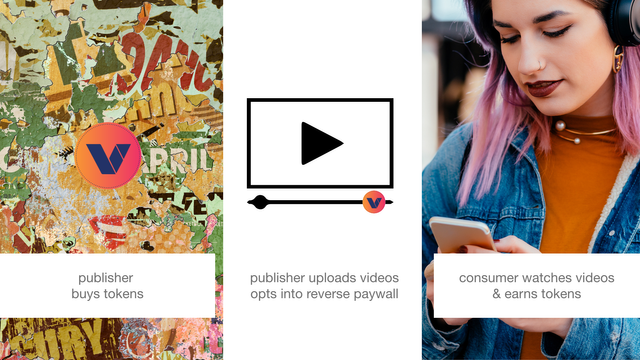Vevue: Reverse Paywalls
[Originally published on Medium]
In my introductory article Vevue: Paywalls, I describe a mechanism now somewhat commonly used to monetise content
The version used by Vevue is pretty straightforward but there are a number of variants like that used by Medium, where a reader gets 3 free articles per month and subsequent reading is blocked unless the reader pays (not all content is monetised this way; authors have the choice to place individual articles behind the paywall)
Today I’m going to talk about a Vevue innovation in the works: reverse paywalls
A reverse paywall is a mechanism whereby instead of paying to watch a video, a viewer gets paid
Wait… I get paid to watch movies?? Not quite. The issue of value transfer is at the heart of the token economy
In any system interaction, two or more parties exchange value. Watching a movie means that a producer laboured to create a work that inspires, moves or entertains. A viewer thus has the potential to be so affected, which is valuable to him or her
It is natural, therefore, that in exchange for the inspiration or benefit of the experience, the viewer should pay
This is a well tested model. The general public has long accepted the notion and happily pays at the movie theatre, subscribes to Netflix or Amazon Prime, and now clicks through paywalls on Vevue for desirable content
With advertising, on the other hand, the value of a viewer watching content flows in the opposite direction
It is highly valuable to the advertiser that the video find its audience for, if well crafted, it may compel the viewer to make a purchase, and generally one that well makes the expenditure of creating the content worthwhile
Thus in this case it only makes sense that the viewer should be paid for his or her time
The Advertising Conundrum
Whilst ancient Egyptian merchants posted papyrus ads on city walls to publicise their wares, in China vendors dating back to as far as the 11th century B.C. trumpeted sales of candy using bamboo flutes
The Shem Papyrus (ca. 3,000 B.C.), Thebes, Egypt — the oldest extant advertisement
Today we hate advertising. We mute commercials on television, enable our browsers’ ad-blockers to prevent popups, deploy sophisticated filtering mechanisms to eliminate spam, and generally avoid the constant demand for our attention from those seeking to place product
In part, it’s because in the highly competitive environment for human attention, ads have become intrusive
And unfortunately for advertisers, due to the barrage of ads we are exposed to every day, our brains no longer even register. According to Mast Media¹:
In the book, “Gimme! The Human Nature of Successful Marketing,” John Hallward states that in a study that asked viewers to describe a television ad they had recently seen, only about half could correctly identify the company the advertisement was promoting.
But it gets worse, as I mentioned recently in my article Economic Models in Social Media Networks, according to Juniper Research² almost 10% of advertising budgets are lost due to ad fraud — an astounding $19B in losses for 2018
Ergo the conundrum: how does an advertiser get a message out to a public actively resisting communication?
A Disruptive New Model
The answer lies in choice. We want what we want, when we want it, and under our terms — and technology has empowered us to reject what we don’t want
This doesn’t leave the advertiser out in the cold. It only means that the industry must shift, to accomodate its audience
In fact, we really do want to hear the message
We want to be the first to get the latest iPhone. We’re going to absolutely attend the première of a long expected film. And we want to know about sale events, when we need the stuff we need
So advertising isn’t evil. We can come to love it — and Vevue makes that possible. With reverse paywalls, advertisers can be guaranteed of two facts of paramount importance:
- That the viewer is a real human being (not a bot) and therefore the risk of advertising fraud is zero, and
- That the viewer wants to watch the ad, even if it’s just to receive some tokens — which represents a 180º turn from what we have now, and is all the advertiser cares about anyway: the possibility of a sale
This represents a significant advantage for Vevue over all other platforms
Think about it: television and cable cannot even guarantee anyone’s watching the commercial, websites collude with botnets to inflate viewership, and no platform at present offers a means of presenting ads as if the ads themselves were the product — which they are
To summarise, the reverse paywall mechanism in Vevue offers an amazing opportunity: to rescue the advertising industry from a sinking ship and deliver it into the arms of a welcoming party
Welcome to the new economy
- footnotes -
[1] see: Desensitization threatens advertisers
[2] https://www.businesswire.com/news/home/20170926005177/en/Juniper-Research-Ad-Fraud-Cost-Advertisers-19
If you love what Vevue is doing, you can now buy their tokens with a credit card or bank draft, thanks to a new partnership with CryptoSpace. Simply join their Telegram group [https://t.me/VevueInvestors] and learn how!

CryptoSpace now facilitates ownership of Vevue tokens
tweet me: @ekkis
Comments or questions about this article are always most welcome and can be left here as responses on Medium. To reach me more directly please tweet @ekkis
For full disclosure, I’m currently advising Vevue (yes, I think it’s the next unicorn and want to be part of it)



Congratulations @ekkis! You received a personal award!
You can view your badges on your Steem Board and compare to others on the Steem Ranking
Vote for @Steemitboard as a witness to get one more award and increased upvotes!